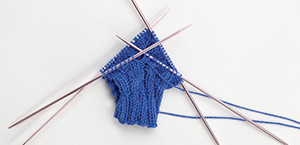HERE ARE SOME SPECIAL TIPS FOR WORKING YOUR PROJECT IN ROUNDS!
When it comes to hats, socks, or shrugs, it’s often simpler to just work on circular or double-pointed needles and avoid sewing a seam. Many garments are worked on circular needles to the armholes, as well, before dividing the stitches and working on straight needles for the yoke and sleeves. Many of you might be quite comfortable working back and forth on straight needles, making scarves or shawls without seams.
On straight needles, one row is worked on the right side and then the piece is turned to work the next row on the wrong side. However, when working in the round, you continue to work on the right side without turning the work to the wrong side. This entails making some adjustments in how you’ll knit the item.
Between the first and final stitch of the round, a stitch marker is most helpful, otherwise it is too easy to continue knitting and forget exactly where you started.
Since you are always working on the right side, to create a stockinette stitch piece in the round, you’ll continue to knit each round instead of knitting one row and purling the next as on straight needles. For a garter stitch, instead of knitting each row as on straight needles, you’ll need to knit one round and then purl the next round to achieve the garter stitch look.
In the case of working pattern stitches or ribbing in rounds, the pattern repeat needs to work evenly, so that the pattern continues on with any type of break. The designer has taken this into consideration, when they wrote the pattern.
Circular needles are available in many different lengths, in order to accommodate several different numbers of stitches. When working on circular needles, the stitches must fit comfortably around the needle without gaps between the stitches. It will be necessary, quite often, to use several lengths of needles, as in the case of hats, where there are very few stitches after decreasing to form the top portion of the hat.
Double-pointed needles are used when the circumference is too small to fit on a circular needle as with the glass cozy. When working on double-pointed needles, after casting on, divide the stitches among the needles. The piece is then worked in the round, working across one needle, and then the next continuing until the round is complete.
Finally, in the case of some items, like Afghans, they call for a circular needle, but the stitches are worked in rows. The circular needle is longer than straight needles, so it allows more stitches to fit on the length of the needle and prevents stitches from accidentally dropping off the end of needle.
Now you know some of the differences between working on straight needles and circular ones, why not try one of these projects that goes round and round.







